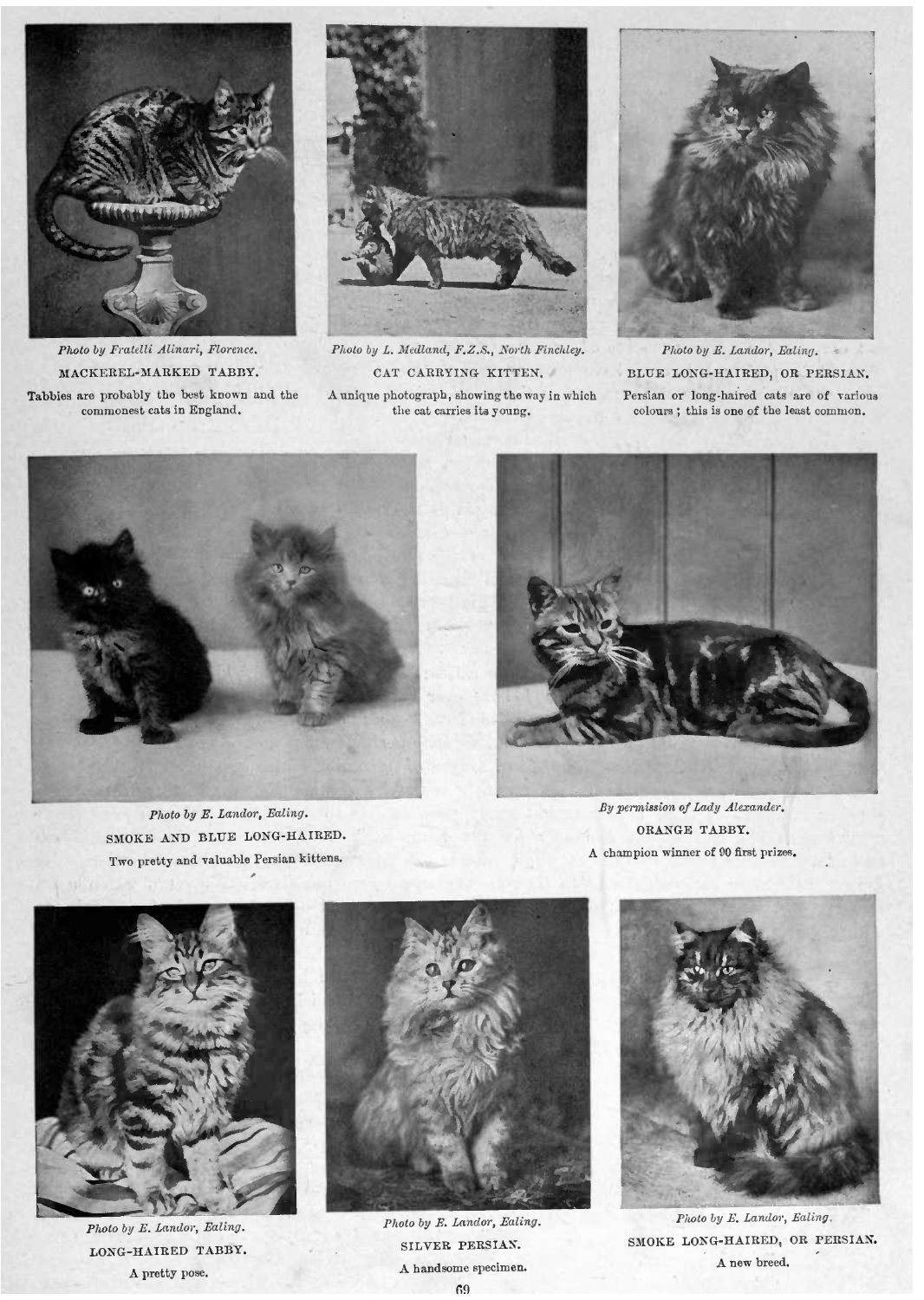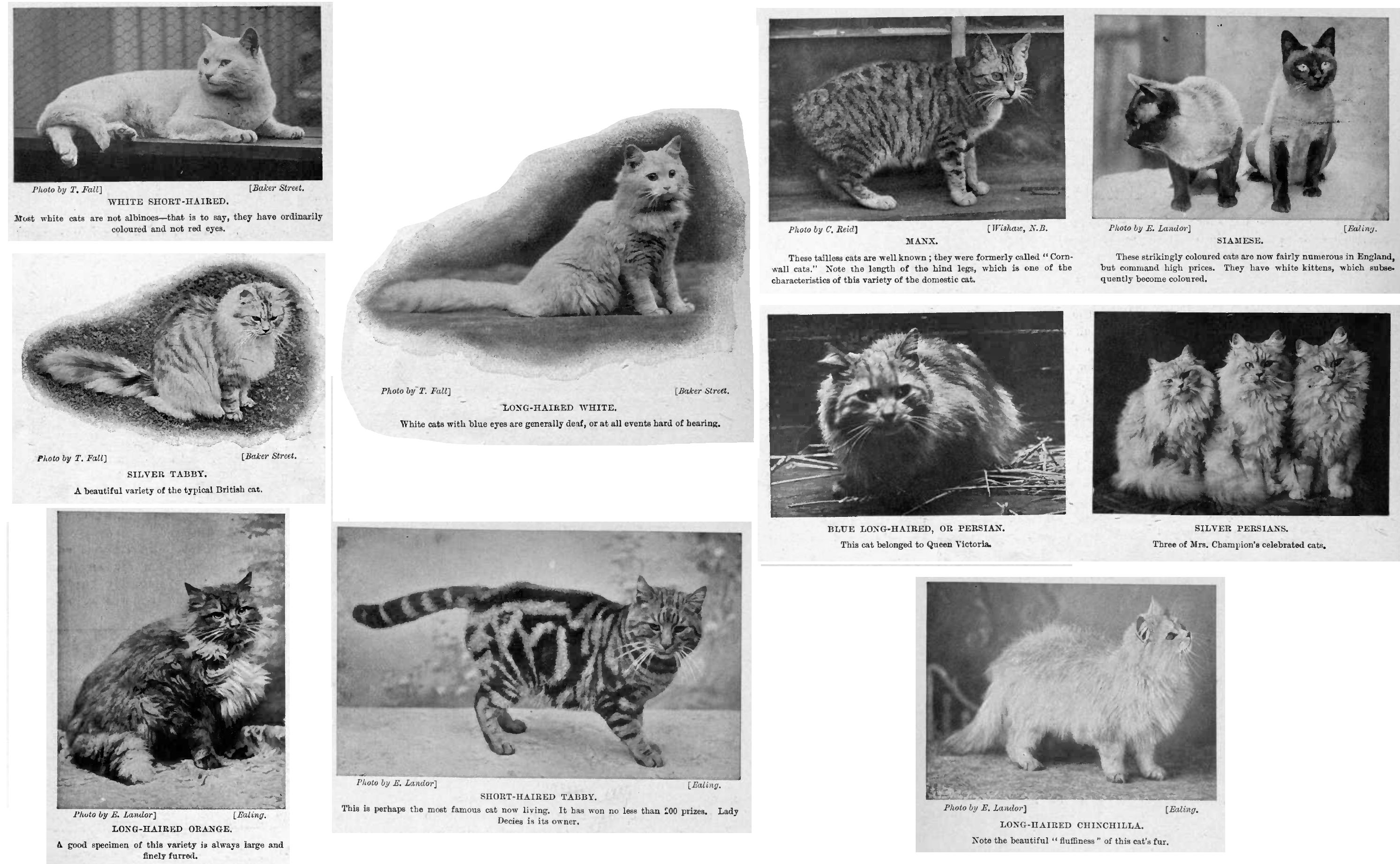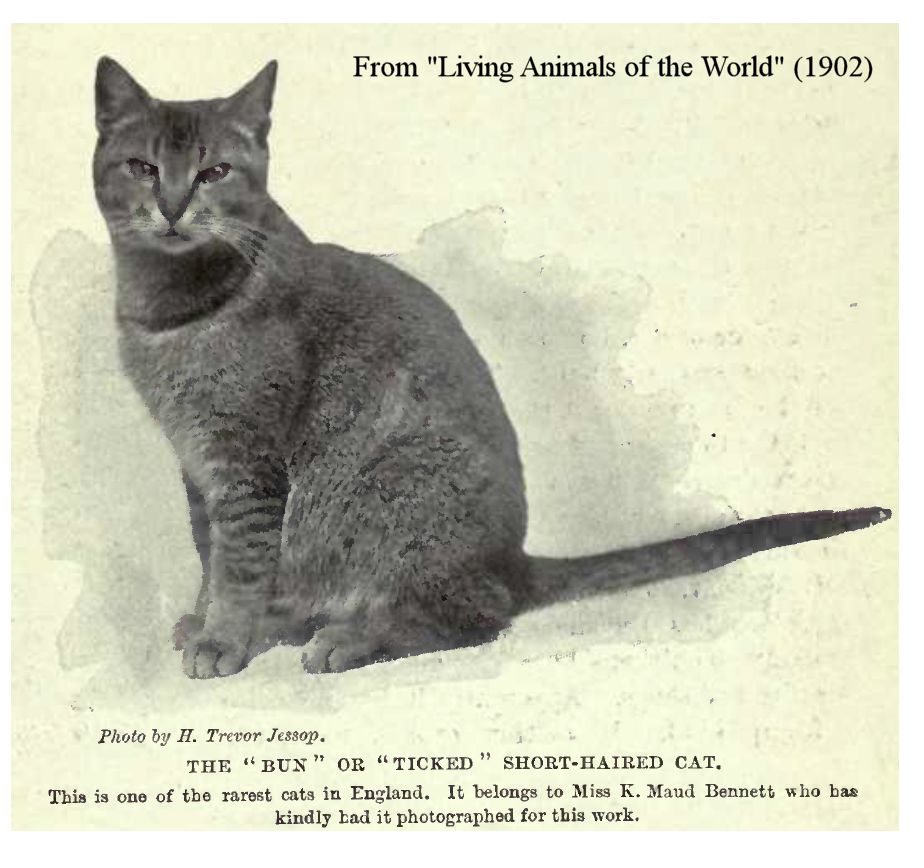
THE DOMESTIC CAT.
BY LOUIS WAIN
From: THE LIVING ANIMALS OF THE WORLD; A POPULAR NATURAL HISTORY WITH ONE THOUSAND ILLUSTRATIONS (1902)
OF the domestication of the cat we know very little, but it is recorded that a tribe of cats was trained to retrieve i.e. to fetch and carry game. In our own time I have seen many cats fetch and carry corks and newspapers, and on one occasion pounce upon a small roach at the end of a line and place it at its owner's feet. Gamekeepers whom I have known agree that, for cunning, craftiness, and tenacity in attaining an object, the semi-wild cat of the woods shows far superior intelligence to the rest of the woodland denizens. It is quite a usual thing to hear of farm cats entering upon a snake-hunting expedition with the greatest glee, and showing remarkable readiness in pitching upon their quarry and pinning it down until secured. These farm cats are quite a race by themselves. Of decided sporting proclivities, they roam the countryside with considerable fierceness, and yet revert to the domesticity of the farmhouse fireside as though innocent of roving instincts. They are spasmodic to a degree in their mode of life, and apparently work out one mood before entering upon another. It will be remembered that this spasmodic tendency the true feline independence, by-the-bye is and has been characteristic of the cat throughout its history, and any one who has tried to overcome it has met with failure.
Watch your own cat, and you will see that he will change his sleeping-quarters periodically ; and if he can find a newspaper conveniently placed, he will prefer it to lie upon, before anything perhaps, except a cane-bottomed chair, to which all cats are very partial. If you keep a number of cats, as I do, you will find that they are very imitative, and what one gets in the habit of doing they will all do in time : for instance, one of my cats took to sitting with his front paws inside my tall hat and his body outside, and this has become a catty fashion in the family, whether the object be a hat, cap, bonnet, small basket, box, or tin. If by chance one of the cats is attacked by a dog, a peculiar cry from the aggrieved animal will immediately awaken the others out of their lethargy or sleep, and bring them fiercely to the rescue. They are, too, particularly kind and nice to the old cat, and are tolerant only of strange baby kittens and very old cats in the garden as long as they do not interfere with the " catty " subject. The same quality obtains in Spain or Portugal, where a race of scavenging cats exists, which go about in droves or families, and are equal to climbing straight walls, big trees, chimneys, and mountainsides. Long, lanky, and thin, they are built more on the lines of a greyhound than the ordinary cat, and are more easily trained in tricks than home cats. .
The TORTOISESHELL has long been looked upon as the national cat of Spain, and in fact that country is overrun with the breed, ranging from a dense black and brown to lighter shades of orange-brown and white. The pure tortoiseshell might be called a black and tan, with no white, streaked like a tortoiseshell comb if possible, and with wonderful amber eyes. It is characteristic of their intelligence that they will invariably find their way home, and will even bring that mysterious instinct to bear which guides them back long distances to the place of their birth; and, with regard to this cat, the stories of almost impossible journeys made are not one bit exaggerated. The tom-cats of this breed are very rare in England ; I myself have only known of the existence of six in fifteen years, and of these but three are recorded in the catalogues of our cat shows.
The BLACK CAT has many of the characteristics of the tortoiseshell, but is essentially a town cat, and is wont to dream his life away in shady corners, in underground cellars, in theatres, and in all places where he can, in fact, retire to monastic quiet. The black cat of St. Clement Danes Church was one of the remarkable cats of London. It was his wont to climb on to the top of the organ-pipes and enjoy an occasional musical concert alone. A christening or a wedding was his pride ; and many people can vouch for a lucky wedding who had the good-fortune to be patronised by the black cat of St. Clement Danes, which walked solemnly down the aisle of the church in front of the happy couples.

My old pet Peter was a black-and-white cat, and, like most of his kind, was one of the most remarkable cats for intelligence I have ever known. A recital of his accomplishments would, however, have very few believers a fact I find existing in regard to all really intelligent cats. There are so many cats of an opposite character, and people will rarely take more than a momentary trouble to win the finer nature of an animal into existence. Suffice it to say, that Peter would lie and die, sit up with spectacles on his nose and with a post-card between his paws a trick I have taught many people's cats to do. He would also mew silent meows when bid, and wait at the door for my home-coming. For a long time, too, it was customary to hear weird footfalls at night outside the bedroom doors, and visitors to the house were a little more superstitious as to their cause than we were ourselves. We set a watch upon the supposed ghost, but sudden opening of the doors discovered only the mystic form of Peter sitting purring on the stairs. He was. however, ultimately caught in the act of lifting the corner of the door-rug and letting it fall back in its place, and he had grown quite expert in his method of raising and dropping it at regular intervals until he heard that his signals had produced the required effect, and the door was opened to admit him.
WHITE CATS. I might call musical cats, for it is quite characteristic of the albinoes that noises rarely startle them out of their simpering, loving moods. The scraping of a violin, which will scare an ordinary cat out of its senses, or the thumping of a piano, which would terrorise even strong-nerved cats, would only incite a white cat to a happier mood. Certainly all white cats are somewhat deaf, or lack acute quality of senses ; but this failing rather softens the feline nature than becomes dominant as a weakness.
The nearest to perfection perhaps, and yet at the same time extremely soft and finely made, is the BLUE CAT, rare in England as an English cat, but common in most other countries, and called in America the Maltese Cat for fashion's sake probably, since it is too widely distributed there to be localised as of foreign origin. It is out in the mining districts and agricultural quarters, right away from the beaten tracks of humanity, where the most wonderful breeds of cats develop in America ; and caravan showmen have told me that at one time it was quite a business for them to carry cats into these wildernesses, and sell them to rough, hardy miners, who dealt out death to each other without hesitation in a quarrel, but who softened to the appeal of an animal which reminded them of homelier times.

One man told me that upon one occasion he sold eight cats at an isolated mining township in Colorado, and some six days' journey farther on he was caught up by a man on horseback from the township, who had ridden hard to overtake the menagerie caravan, with the news that one of the cats had climbed a monster pine-tree, and that all the other cats had followed in his wake ; food and drink had been placed in plenty at the foot of the tree, but that the cats had been starving, frightened out of their senses, for three days, and despite all attempts to reach them they had only climbed higher and higher out of reach into the uppermost and most dangerous branches of the pine. The showman hastened with his guide across country to the township, only to find that in the interval one bright specimen of a man belonging to the village had suggested felling the tree, and so rescuing the cats from the pangs of absolute starvation, should they survive the ordeal. A dynamite cartridge had been used to blast the roots of the pine, and a rope attached to its trunk had done the rest and brought the monster tree to earth, only, however, at the expense of all the cats, for not one survived the tremendous fall and shaking. A sad and tearful procession followed the remains of the cats to their hastily dug grave, and thereafter a bull mastiff took the place of the cats in the township, an animal more in character with the lives of its inhabitants.
Analogous to this case of the travelling menageries, we have the great variety of blues, silvers, and whites which are characteristic of Russia. There is a vast tableland of many thousands of miles in extent, intersected by caravan routes to all the old countries of the ancients, and it is not astonishing to hear of attempts being made to steal the wonderful cats of Persia, China, and Northern India, as well as those of the many dependent and independent tribes which bound the Russian kingdom. But it is a remarkable fact that none but the blues can live in the attentuated atmosphere of the higher mountainous districts through which they are taken before arriving in Russian territory. It is no uncommon thing to find a wonderful complexity of blue cats shading to silver and white in most Russian villages, or blue cats of remarkable beauty, but with a dash of tabby-marking running through their coats. Their life, too, is lived at the two extremes. In the short Russian summer they roam the woodlands, pestered by a hundred poisonous insects; in the winter they are imprisoned within the four walls of a snow-covered cottage, and are bound down prisoners to domesticity till the thaw sets in again. Many of the beautiful furs which come to us from Russia are really the skins of these cats, the preparation of which for market has grown into a large and thriving industry. The country about Kronstadt, in the Southern Carpathian Mountains of Austria, is famous for its finely developed animals; and here, too, has grown up a colony of sable-coloured cats, said to be of Turkish origin, where the pariahs take the place of cats.
The TABBY is remarkable to us in that it is characteristic of our own country, and no other colour seems to have been popular until our own times. If you ask any one which breed of cat is the real domestic cat, you will be told the tabby, probably because it is so well known to all. The complexity of the tabby is really remarkable, and for shape and variety of colouring it has no equal in any other tribe of cat. It has comprised in its nature all the really great qualities of the feline, and all its worst attributes. You can truthfully say of one of its specimens that it attaches itself to the individual, while of another in the same litter you will get an element of wildness. A third of the same parents will sober down to the house, but take only a passing notice of people. You can teach it anything if it is tractable, make it follow like a dog, come to whistle, but it will have its independence.
The SAND-COLOURED CAT, with a whole-coloured coat like the rabbit, which we know as the ABYSSINIAN or BUNNY CAT, is a strong African type. On the Gold Coast it comes down from the inland country with its ears all bitten and torn away in its fights with rivals. It has been acclimatised in England, and Devonshire and Cornwall have both established a new and distinct tribe out of its parentage. The MANX CAT is nearly allied to it, and a hundred years ago the tailless cat was called the Cornwall Cat, not the Manx.

Siam sends us a regal animal in the SIAMESE ROYAL CAT ; it has a brown face, legs, and tail, a cream-coloured body, and mauve or blue eyes. The Siamese take great care of their cats, for it is believed that the souls of the departed are transmitted into the bodies of animals, and the cat is a favourite of their creed; consequently the cats are highly cultivated and intelligent, and can think out ways and means to attain an end.
I have tried for years to trace the origin of the LONG-HAIRED or PERSIAN CATS, but I cannot find that they were known to antiquity, and even the records of later times only mention the SHORT-HAIRED. European literature does not give us an insight into the subject ; and unless Chinese history holds some hidden lights in its records, we are thrown back upon the myths of Persia to account for the wonderful modern distribution of the long-haired cat, which is gradually breeding out into as many varieties as the short-haired, with this difference that greater care and trouble are taken over the long-haired, and they will, as a breed, probably soon surpass the short-haired for intelligence and culture.
One variety is quite new and distinctive the SMOKE LONGHAIRED, whose dark brown or black surface-coat, blown aside, shows an under-coat of blue and silver, with a light brown frill round its neck. All the other long-haired cats can pair with the short-haired for colouring and marking, but I have not yet seen a BUNNY-LONG-HAIRED